Orient FER27008W0, FER24009W0, FDB08005W0, FER2J001B0, FNR1Q005W0 User Manual [it]
...
ENGLISH
MECHANICAL WATCHES
INSTRUCTION MANUAL
Thank you for choosing our product. To ensure prolonged use and optimum performance, please read this instruction manual carefully and familiarize your-self with the terms of the guarantee.
Please keep this Instruction Manual handy for future reference.
SAFETY PRECAUTIONS
Make absolutely sure to observe the demarcated contents indicated below to prevent any possible physical danger and property damage to you as well as other people concerned.
!WARNING
!CAUTION
... A demarcation with this symbol represents the contents assuming possibility for death or serious injury when the product is used in any manner different from given instructions.
... A demarcation with this symbol represents the contents assuming possibility of causing human injury or material damage only when a product is used in any manner different from given instructions.
ENGLISH
1
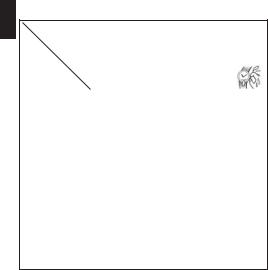
ENGLISH
IN HANDLING THE WATCH
(1) Water-resistance
|
Conditions |
Exposure to |
Water sports |
Skin diving |
Scuba diving |
Underwater |
|
of use |
small amounts |
(swimming, etc.), |
(air tanks are |
(air tanks are |
operation of |
|
|
of water |
frequent contact |
not used) |
used) |
crown and |
|
|
(facewashing, |
with water (car- |
|
|
operation of |
|
|
rain, etc.) |
washing, etc.) |
|
|
crown with |
|
|
|
|
|
|
drops of water |
|
|
|
|
|
|
on it |
Type |
|
|
|
|
|
|
Non water |
Watch without |
|
|
|
|
|
resistant |
WATER |
× |
× |
× |
× |
× |
|
RESISTANT on |
|||||
|
back cover of |
|||||
|
watchcase. |
|
|
|
|
|
Water |
Watch with WATER |
|
× |
× |
× |
× |
resistant |
RESISTANT on |
|
||||
for daily |
back cover of |
|||||
life |
watchcase. |
|
|
|
|
|
Reinforced |
Watch with 50M |
|
|
|
|
|
water |
(5BAR) on back |
|
|
|
|
|
resistance |
cover or dial face |
|
|
× |
× |
× |
for daily |
along with WATER |
|||||
life I |
RESISTANT on |
|||||
|
back cover of |
|
|
|
|
|
|
watchcase. |
|
|
|
|
|
Reinforced |
Watch with 100M |
|
|
|
|
|
water |
(10BAR), 150M |
|
|
|
|
|
resistance |
(15BAR), 200M |
|
|
|
|
|
for daily |
(20BAR) on back |
|
|
|
× |
× |
life II |
cover or dial face |
|||||
|
along with WATER |
|||||
|
RESISTANT on |
|
|
|
|
|
|
back cover of |
|
|
|
|
|
|
watchcase. |
|
|
|
|
|
*It is recommended that you use the watch correctly following the above-mentioned scope of usage after ascertaining water resistance precautions marked on the dial face of the watch or on the back of the watchcase.
2

! |
WARNING |
ENGLISH |
|
1 A watch with water resistance for daily life 30M (3 bar) can be used during face-washing, etc. but cannot be used in an environment in which it will be submerged in water.
2A watch with reinforced water resistance for daily life I 50M (5 bar) can be used while swimming, etc. but cannot be used during any type of diving
including skin diving.
3A watch with reinforced water resistance for daily life II 100M or 200M (10 or 20 bar) can be used while skin diving, but cannot be used while scuba diving using oxygen tanks or saturation diving using helium gas, etc.
!CAUTION
4Keep the crown pushed in at all times (in the normal position) while using the watch. If the crown is the screwed-down type, check that it is securely
screwed down.
5 Do not operate the crown underwater, or while the watch is wet. Water may enter the interior of the watch and defeat the water resistance.
6If your watch is non-water resistant, beware of splashes of water (during face washing, rain, etc.) and sweat. If the watch becomes wet from water or sweat, wipe the moisture off with a dry, soft cloth.
7Even with a water resistant watch for everyday use, avoid directing strong jets of mains water onto the watch. Water pressure above the limit can apply, which may defeat the water resistance.
8With a water resistant watch for everyday use, rinse sea water off the case after exposure, then wipe it thoroughly to avoid corrosion and other effects.
9 The interior of the watch contains some amount of moisture, which may cause fogging on the inside of the glass when the outside air is cooler than the internal temperature of the watch. If the fogging is temporary it causes no harm inside the watch, but if prolonged, or if water enters the watch, consult your place of purchase and do not leave the problem untreated.
3

ENGLISH
(2) Shock
1 Be sure not to carry the watch when you engage in strenuous sports, whereas playing such light sports as golf, etc., will not adversely influence the watch.
2 Avoid a violent shock such as dropping the watch on the floor.
(3) Magnetism
1 If the watch is left at a location with strong magnetism for an extended period of time, the components may be magnetized, resulting in malfunction. Be careful.
2 The watch may temporarily speed up or slow down when exposed to magnetism. Precision is restored when placed away from magnetism. In such a case, reset the time.
(4)Vibration
The watch may lose precision if subjected to strong vibrations such as from riding motorcycles, using jackhammers, chain saws, etc.
(5)Temperature
In environments below and above normal temperatures (5°C-35°C), the watch may malfunction and stop.
!CAUTION
Do not use the watch at high temperatures, such as in a sauna. The watch may heat and cause burns.
(6)Chemicals, Gases, etc.
Utmost caution must be exercised when coming into contact with gases, mercury, chemicals (paint thinner, gasoline, various solvents, detergents containing such components, adhesives, paint, drugs, perfumes, cosmetics, etc.), and so forth. Such may cause discoloration of the watchcase, watchband, and dial face. Discoloration, deformation, and damage to various resin-based component parts may also occur.
4

(7) About accessory parts
!WARNING
Store the bracelet/strap pin and other small parts out of the reach of children.
If any small parts are swallowed, immediately contact a doctor.
(8) Allergic reactions
!CAUTION
If you develop a skin rash or your skin becomes abnormally irritated due to contact with the watch or strap, stop wearing the watch immediately and consult a doctor.
(9)About “luminous light”
Some products have luminous light on the hands and dial.
The luminous light is a safe paint that stores sunlight and artificial light without using any radioactive material, and emits that light in a dark setting. As the paint discharges the stored light, it will become dimmer over time. The amount of light emitted and the time that light is emitted depends on various factors when the light is stored, such as the shape of the glass, the thickness of the paint, surrounding brightness level, the distance from the watch to the light source, and the light absorption level. Please note that when not enough light energy is stored, the watch may emit weak light or emit light for only a short time.
(10)Water resistant watchband
Some products employ leather and nylon bands on which a special treatment to resist perspiration and water absorption have been applied. Please understand that the water resisting effect of this watchband can be lost depending on the period and conditions of use.
ENGLISH
5
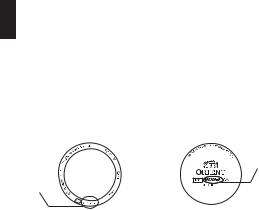
ENGLISH
HOW TO IDENTIFY THE CALIBER NUMBER
Check the caliber number by referring to the model number of your watch or the case code on the watch’s case back.
1. Searching by 10-digit model number
Check the 10-digit model number on the guarantee supplied with your watch. You can also see the number on the product tag put on the watch. Its second and third digits indicate the caliber number of your watch.
Example: If the model number is “CDB05001B0”, the caliber number is “DB”.
2. Searching by the case code
See the case code on the case back of your watch.
A:If the case code is 6 digits, the first two digits indicate the caliber number.
B:If the case code is 8 or 9 digits, the first three digits indicate the movement number. Search the caliber number corresponding to the movement number referring to the correspondence table.
Example A |
Example B |
Case code
Case code
Example A : When the case code is “DB05-C0”, the caliber number is “DB”. Example B : When the case code is “469396-81”, the movement number is “469”. The caliber number corresponding the number will be
found “EM” on the table.
*The place of case code may vary and its letter size may be small and difficult to see depending on the characteristics of watches.
*The pictures and illustrations on this manual may differ from the actual appearance of your watch but the function and operation procedures are the same.
6

SPECIFICATIONS
Caliber |
Click-B |
Date |
Day of week |
Hand winding |
Daily accuracy |
Remark1* |
|
DB |
46A |
– |
– |
– |
– |
+25~-15s/day |
– |
DW |
48D |
– |
○ |
– |
– |
+25~-15s/day |
9:00PM-2:00AM |
EM |
469 |
○ |
○ |
○ |
– |
+25~-15s/day |
9:00PM-4:00AM |
ER |
487 |
– |
○ |
– |
– |
+25~-15s/day |
9:00PM-2:00AM |
NP |
558 |
○ |
○ |
○ |
○ |
+40~-30s/day |
8:30PM-2:00AM |
NQ |
559 |
– |
○ |
○ |
○ |
+40~-30s/day |
8:30PM-4:00AM |
NR |
557 |
– |
○ |
– |
○ |
+40~-30s/day |
8:30PM-0:30AM |
PF |
597 |
– |
○ |
– |
○ |
+40~-30s/day |
8:30PM-0:30AM |
PM |
599 |
– |
○ |
○ |
○ |
+40~-30s/day |
8:30PM-4:00AM |
(1)Vibrations: 21,600 vibrations/1 hour
(2)Number of jewels: 21 jewels
(3)Running time: More than 40 hours
(4)Shock-proof bearings to protect the balance with hairspring from shocks.
The stated daily accuracy is in the following conditions:
•After 24 hours at room temperature with the mainspring wound fully and the dial facing up.
•Due to the characteristics of the automatic winding watch, the time may deviate from the stated “daily accuracy” depending on the following conditions: amount of time the watch is worn each day, position of the watch, movement of your arm, winding condition of the mainspring.
Product specifications may change without notice, for improvement.
!CAUTION
* Avoid setting the date during the time periods listed in “Remark1” above since the calendar changes during this time. If the date is set during this time period, the date may not change or the watch may malfunction. Be sure to move the hour and minute hands away from this time period when setting the date.
ENGLISH
7
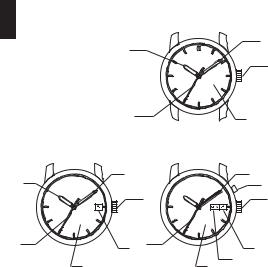
ENGLISH
NAMES AND FUNCTIONS OF INDIVIDUAL COMPONENT PARTS
A:Hour hand |
|
<DB(46A)> |
|
|
B |
||
B:Minute hand |
A |
||
|
|||
C:Second hand |
|
||
D:Crown |
|
D |
|
E:Dial |
|
||
F: Click button |
|
|
|
* EM(469) & NP(558) only |
|
|
|
G:Date |
|
|
|
H:Day of the week |
|
|
|
|
C |
E |
|
|
|
<DW(48D), ER(487), NR(557), PF(597)> <EM(469), NP(558), NQ(559), PM(599)>
B B
A 

 A
A 

 F
F 
 D
D 
 D
D
C 
 G C
G C 
 G
G
H
E E
*The position of the crown, date indicator, or day of the week window may be different, depending on the model.
8

AUTOMATIC WINDING MECHANISM
(1)The mainspring is wound by natural movements of your arm when wearing the watch on your wrist.
(2)If your watch stops, swing the watch back and forth ten or more times to re-start the second hand. After it starts moving, set the date and time.
(3)This watch will run approximately 40 hours after it is fully wound. If it is not wound enough, the watch may lose accuracy. In order to maintain the watch’s accuracy, we recommend wearing the watch at least 8 hours a day.
HAND WINDING MECHANISM
(1)The mainspring is wound up manually.
(2)To wind the spring, turn the crown clockwise.
When you turn the crown counterclockwise, the spring will not be wound.
(3)Once the spring is fully wound, the crown will no longer turn. Be careful not to keep trying to turn it, or the spring or other parts may be broken.
(4)This watch will run approximately 40 hours after the spring is fully wound.
MODELS WITH SCREWED-DOWN CROWN
Depending on the model, you may not be able to pull the crown out without unscrewing it (models with screwed-down crown).
Operate this type of watch as follows:
(1)Before setting the date and time, first turn the crown to the left to loosen the screw lock.
(2)After setting the date and time, turn the crown to the right while pressing in, until it stops turning to securely tighten the screw.
ENGLISH
9
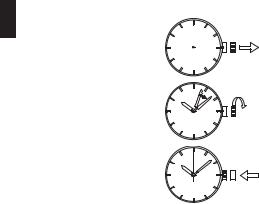
ENGLISH
HOW TO SET THE TIME [DB(46A)]
(1) Pull the crown out.
(The second hand does not stop.)
(2) Turn the crown clockwise and set the |
Turn clockwise |
|
current time. |
||
|
When setting the time, first bring the hand back slightly later than the actual time and then move it forward to the actual time.
(3) Press the crown in to the normal position.
10
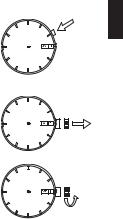
HOW TO SET THE TIME & CALENDAR [EM(469), NP(558)]
(1) Press the click button and set the previous day of the week.
The day of the week can be displayed in two languages. Press the click button to select your desired languages.
The languages available differ depending on the model.
(2) Pull the crown out to the first click. The crown on this watch can be pulled out to the first and second clicks.
(3) Turn the crown counterclockwise to set the date indicator to the previous date.
About date correction at month’s end: |
|
Date correction is necessary for months |
|
with 30 days or less. In this case, set the |
Turn |
date to the [1st day] on the first day of the |
counterclockwise |
next month. |
|
ENGLISH
11
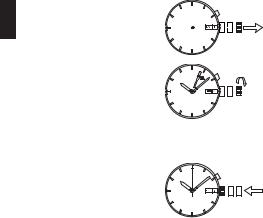
(4) Pull the crown out to the second click.
ENGLISH
(5) Turn the crown to set the time.
Turn clockwise
Turn the crown in the direction to advance the hand (clockwise) until today’s date is displayed. It is the “a.m.” when the date changes. Set the
hands further forward to adjust to the current time.
Since the calendar changes at midnight, take care not to confuse a.m. and p.m. when setting the time.
(6)Push the crown back to the normal position.
12
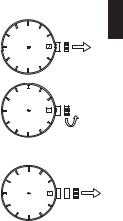
HOW TO SET THE TIME & DATE [DW(48D), ER(487), NR(557), PF(597)]
(1)Pull the crown out to the first click. The crown on this watch can be pulled out to the first and second clicks.
(2)Turn the crown counterclockwise to set the date indicator to the previous date.
About date correction at month’s end: Date correction is necessary for months with 30 days or less. In this case, set the date to the [1st day] on the first day of the next month.
(3)Pull out the crown to the second click. The second hand does not stop.
ENGLISH
Turn counterclockwise
13
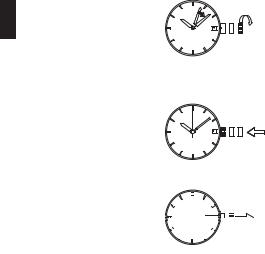
ENGLISH
(4)Turn the crown clockwise and set the current time.
Since this watch comes with a calendar, make sure that you set either a.m. or p.m. without fail.
The date changes at [twelve o’clock midnight].
When setting the time, first bring the hand back slightly later than the actual time and then move it forward to the actual time.
(5)Press the crown in to the normal position.
Turn clockwise
HOW TO SET THE TIME & CALENDAR [NQ(559), PM(599)]
(1)Pull the crown out to the first click. 

The second hand does not stop. 

(2)At first turn the crown clockwise to the 









 previous day of the week.
previous day of the week. 

The day of the week can be 
 displayed in two languages. Press
displayed in two languages. Press
the click button to select your desired languages.
The languages available differ depending on the model.
14
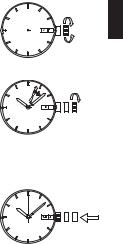
Turn the crown counterclockwise to set the date indicator to the previous date.
About date correction at month’s end: Date correction is necessary for months with 30 days or less. In this case, set the date to the [1st day] on the first day of the next month.
(3)Pull the crown out to the second click.
(4)Turn the crown to set the time. Turn the crown in the direction to advance the hand (clockwise) until today’s date is displayed.
It is the “a.m.” when the date changes. Set the hands further forward to adjust to the current time.
Since the calendar changes at midnight, take care not to confuse a.m. and p.m. when setting the time.
(5)Press the crown in to the normal position.
Turn clockwise (Day setting)
Turn counterclockwise (Date setting)
Turn clockwise
ENGLISH
15

ENGLISH
U HOW TO SET THE MONTHLY CALENDAR
Some models come with a monthly calendar.
The monthly calendar can be used by turning the crown at the 4 o’clock position to set the rotating ring inside the watchcase and aligning it with the day of the week that is printed on the dial.
Turn the crown to align the first day of the month to the appropriate day of the week.
*Note that when setting the first day of the month, if the days at the end of the month (31st, etc.) are aligned with the section that does not have the days of the week printed on the dial (3 - 4 o’clock side), days of the week will not be indicated at the end of the month.
U HOW TO USE “MULTI-YEAR CALENDAR”
You can easily use the calendar for the year printed on the rotating ring by operating the crown.
Depending on the model, the month on the six o’clock side may be printed in roman numerals or alphabet.
Example 1: To set October 2007 |
|
|||
(1) |
Turn the crown and set “07” on the rotating |
Rotating ring: |
||
|
ring to “OCT” on the six o’clock side. |
|||
(2) |
Year and day of the week are printed. |
|||
The calendar for October 2007 is set on |
Example 2: |
|||
|
the twelve o’clock side of the dial. |
|||
Example 2: To set February 2008 (Leap year) |
|
|||
(1) |
Turn the crown and set “08” on the rotating |
|
||
|
ring to “ |
” on the six o’clock side. |
|
|
* Set to “ |
” or “ |
” only for leap years. |
|
|
Other months are the same for leap and |
|
|||
non leap years. |
|
|
||
(2) |
The calendar for February 2008 is set on |
January and February of a leap year |
||
the twelve o’clock side of the dial.
* January and February for leap years are highlighted.
16
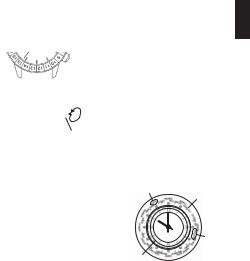
U WORLD TIME
You can see the time in cities around the world by turning the crown (2) to the present time of one of the cities printed on the dial. In the figure on the right, since the time in Tokyo is 10:08, align “10” on the rotating indicator ring to “TOKYO” on the dial. To tell the time in other cities, simply look at the corresponding numbers on the rotating indicator ring.
Crown (2)
Using the World Time Ring, you can see the times all around the world.
Example: It is 10 p.m. now.
(1) In the 24-hour system, 10 p.m. is 22:00 hours.
(2)Set TOKYO on the World Time Ring to the 22-hour position of the 24-hour scale.
*The World Time Ring comes in various types, such as with a crown for setting world time or with a rotating bezel.
(3)The position that CHICAGO on the World Time Ring indicates is the time in Chicago.
TOKYO |
World |
|
Time Ring |
|
CHICAGO |
24-hour |
|
scale |
|
*The position indicated by each scale on the World Time Ring represents the time in that country.
ENGLISH
17

ENGLISH
Using this method, you can simultaneously see the time in countries around the world by using the scales on the World Time Ring and reading the dial.
*The city names are major cities in various countries around the world.
*Some countries use daylight savings time.
*Note that in some countries policies regarding daylight savings time may be changed by the government ordinance.
USING THE ROTATING INDICATOR BEZEL
Please notice that some models come with a rotating indicator bezel, which should be used properly.
Turn the bezel by pointing the mark to the minutehand. While certain time goes by, you can measure
the elapsed time from the distance between minutehand and figures on the rotating indicator bezel. You can also set the mark as a desired time to remind you how long time is still remain for an
appointment. 












 d
d
You cannot turn the bezel reversely since it comes with a protection mechanism for preventing wrong operation by force or shock. Figures on the bezel could also help you to read the current time easily.
*Depending on design, anti-reversely and 1 minute “click” sound mechanism on rotating indicator ring does not apply to some models.
18

ITALIANO
OROLOGI MECCANICI
MANUALE DI ISTRUZIONI
Grazie di aver acquistato il nostro prodotto. Per garantire un uso prolungato e le migliori prestazioni, leggere con attenzione questo Manuale di istruzioni e familiarizzarsi con le clausole della garanzia.
Tenere questo Manuale di istruzioni a portata di mano e consultarlo nel momento di bisogno.
PRECAUZIONI PER LA SICUREZZA
Osservare con la massima attenzione quanto specificato dai contrassegni sotto indicati per evitare qualsiasi pericolo di danneggiare cose e di ferire voi stessi e altre persone.
!AVVERTENZA
!ATTENZIONE
... Questo simbolo indica la possibilità di causare morte o ferite gravi quando il prodotto viene utilizzato in modo diverso rispetto alle istruzioni fornite.
... Questo simbolo indica la possibilità di ferire persone o danneggiare cose quando il prodotto viene utilizzato in modo diverso rispetto alle istruzioni fornite.
ITALIANO
19
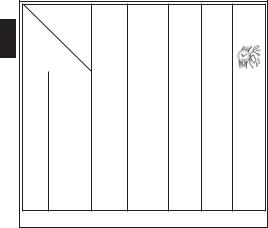
ITALIANO
CURA DELL’OROLOGIO
(1) Resistenza all’acqua
|
Condizioni |
Schizzi |
Sport acquatici |
Immersioni in |
Immersioni |
Utilizzo della |
|
di impiego |
occasionali |
(nuoto, ecc.) e |
apnea |
con |
corona con |
|
|
(lavaggio del |
frequenti contatti |
(senza |
respiratore |
l’orologio |
|
|
viso, pioggia, |
con l’acqua |
bombola |
(con bombola |
bagnato o |
|
|
ecc.) |
(lavaggio dell’auto, |
d’aria) |
d’aria) |
immerso in |
|
|
|
ecc.) |
|
|
acqua |
Tipo |
|
|
|
|
|
|
Non |
“WATER |
× |
× |
× |
× |
× |
resistente |
RESISTANT” non |
|||||
all’acqua |
è scritto sul retro |
|||||
|
dell’orologio. |
|
|
|
|
|
Resistente |
“WATER |
|
× |
× |
× |
× |
all’ acqua |
RESISTANT” è |
|
||||
per l’uso |
scritto sul retro |
|||||
giornaliero. |
dell’orologio. |
|
|
|
|
|
Resistente |
“WATER |
|
|
|
|
|
all’acqua |
RESISTANT” è |
|
|
× |
× |
× |
rinforzato |
scritto sul retro |
|
|
|||
per l’uso |
e 50M (5BAR) è |
|||||
giornaliero |
scritto sul retro o sul |
|
|
|
|
|
I |
quadrante. |
|
|
|
|
|
Resistente |
“WATER |
|
|
|
|
|
all’acqua |
RESISTANT” è |
|
|
|
|
|
rinforzato |
scritto sul retro e |
|
|
|
× |
× |
per l’uso |
100M (10BAR) |
|
|
|
||
giornaliero |
150M (15BAR) |
II200M (20BAR) è scritto sul retro o sul quadrante.
*Si raccomanda di usare l’orologio correttamente, seguendo le note sopra riportate relative all’utilizzo, dopo aver verificato le precauzioni per la resistenza all’acqua riportate sul quadrante o sul retro dell’orologio.
20

!AVVERTENZA
1 I comuni orologi impermeabili resistenti sino alla profondità di 30 metri (3 bar) possono essere usati a contatto con l’acqua, ad esempio quando ci si lava il viso, ma non dovrebbero essere impiegati in immersione.
2 I comuni orologi impermeabili rinforzati per profondità sino a 50 metri (5 bar) possono essere usati durante il nuoto ma non dovrebbero essere impiegati in alcun tipo d’immersione, compresa quella in apnea.
3I comuni orologi impermeabili rinforzati per profondità sino a 100-200 metri (10-20 bar) possono essere usati durante le immersioni in apnea ma non dovrebbero essere impiegati durante quelle con respiratore e ossigeno o o in saturazione d’elio.
!ATTENZIONE
4Mantenere sempre la corona premuta (in posizione normale) quando si utilizza l’orologio. Se la corona è del tipo a vite ci si deve accertare che sia ben serrata.
5 Non utilizzare la corona con l’orologio immerso in acqua o bagnato. L’acqua potrebbe penetrare all’interno dell’orologio e comprometterne la resistenza all’acqua.
6 Se il modello non è impermeabile, fare attenzione agli spruzzi d’acqua (durante le abluzioni, la pioggia, ecc.) e al sudore. Se l’orologio si bagna con acqua o sudore, asciugarlo con un panno soffi ce e asciutto.
7 Anche con orologi resistenti all’acqua per uso normale, evitare forti getti o fl ussi diretti d’acqua verso l’orologio. Potrebbe essere applicata una pressione dell’acqua superiore al limite, che potrebbe comprometterne la resistenza all’acqua.
8 Con orologi resistenti all’acqua per uso normale, asciugare con cura l’acqua di mare dalla cassa dopo l’esposizione, per evitare corrosione e altri effetti indesiderati.
9 L’interno dell’orologio contiene una certa quantità di umidità, che potrebbe provocare formazione di condensa all’interno del vetro, quando l’aria esterna diventa più fredda della temperatura interna dell’orologio. Se la formazione di condensa è temporanea, non provoca danni all’interno dell’orologio, altrimenti, se prolungata o se all’interno dell’orologio penetra acqua, rivolgersi al rivenditore per risolvere il problema quanto prima
possibile.
21
ITALIANO

ITALIANO
(2) Urti
1 Si raccomanda di togliere l’orologio dal polso durante la pratica di sport pesanti, mentre la pratica di quelli leggeri, ad esempio il golf, non v’influisce negativamente.
2 Evitare urti violenti, come il lasciare cadere l’orologio per terra.
(3) Magnetismo
1 Qualora l’orologio venga lasciato nelle vicinanze di un forte magnetismo per un tempo più o meno lungo, le parti componenti possono rimanere magnetizzate fino al punto di causare malfunzionamenti. È opportuno prestare la dovuta attenzione.
2L’orologio può temporaneamente andare avanti o indietro mentre rimane esposto al magnetismo, ma quando viene allontanato dal magnetismo esso riprende il suo funzionamento con la precisione originale. In questo caso correggere l’ora.
(4)Vibrazioni
L’orologio può risultare meno preciso se esposto a forti vibrazioni, come in caso di guida di motociclette, o per l’uso di martelli pneumatici, seghe a catena, ecc.
(5)Temperatura
Alle temperature inferiori o superiori a quelle normali (5-35°C) l’orologio potrebbe non funzionare correttamente o addirittura arrestarsi.
!ATTENZIONE
Non utilizzare l’orologio alle alte temperature, come ad esempio nelle saune. Potrebbe infatti riscaldarsi eccessivamente a causare ustioni.
(6)Prodotti chimici, gas, ecc.
Prestare la massima cautela in caso di contatto con gas, mercurio, prodotti chimici (diluenti, benzina, solventi vari, detergenti contenenti tali componenti, prodotti adesivi, vernici, medicine, profumi, cosmetici) e
così via. In questi casi si potrebbe verificare lo scolorimento della cassa dell’orologio, del cinturino e del quadrante. Si potrebbe anche verificare lo scolorimento, la deformazione e il danneggiamento di vari componenti a
22 base di resina.
